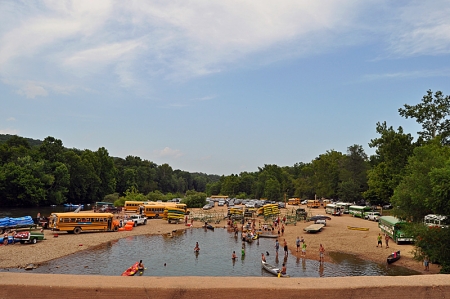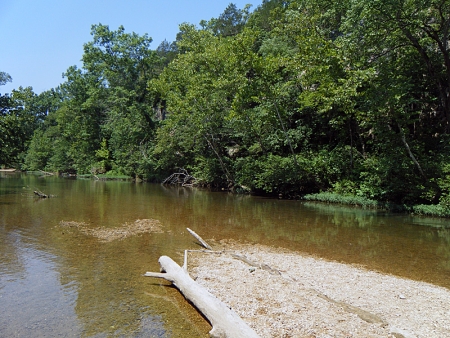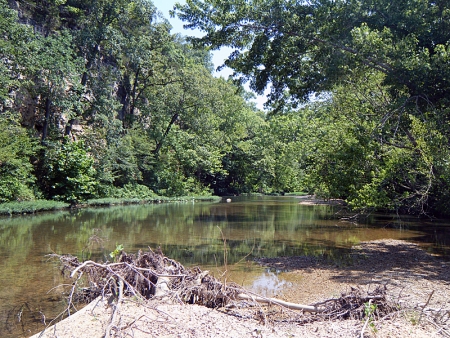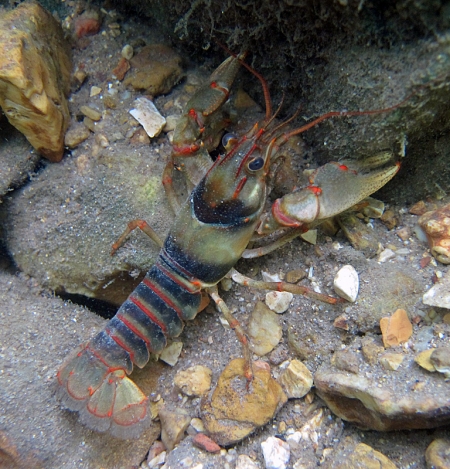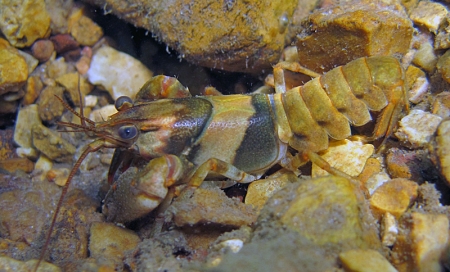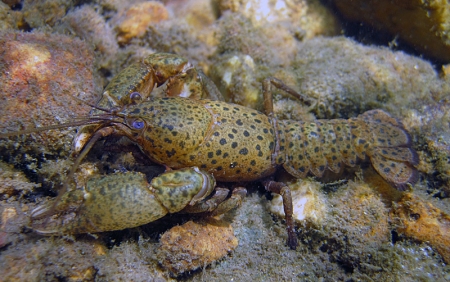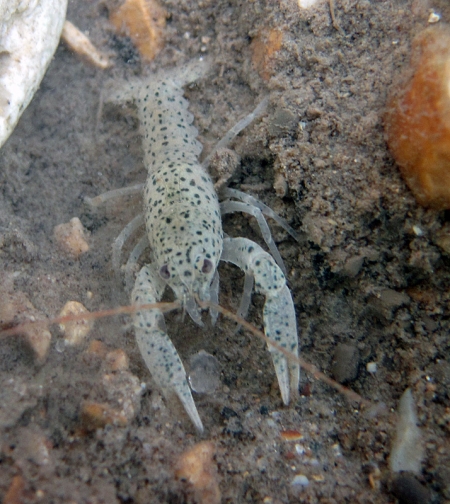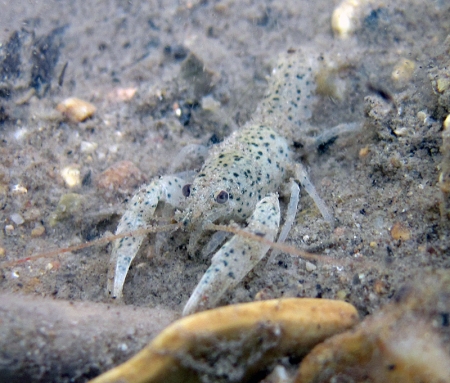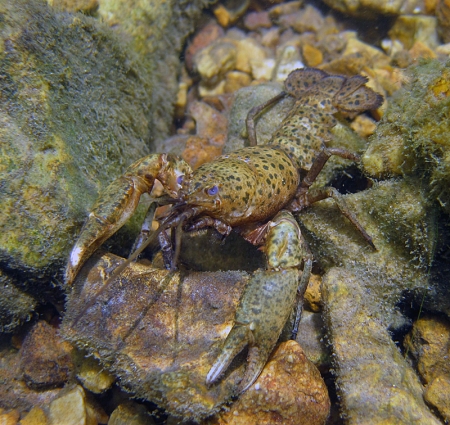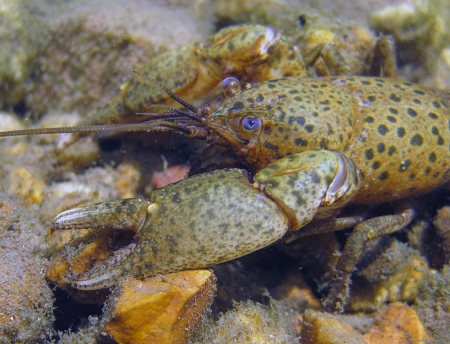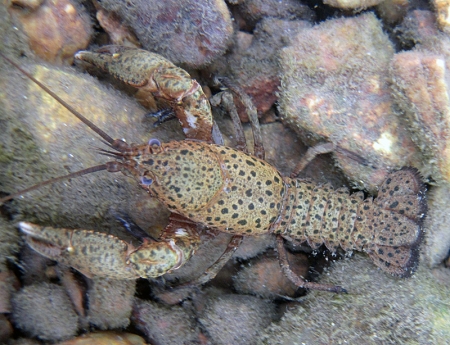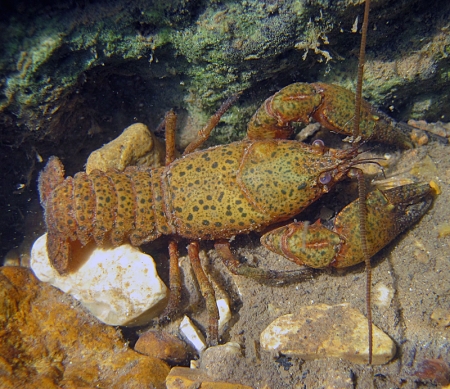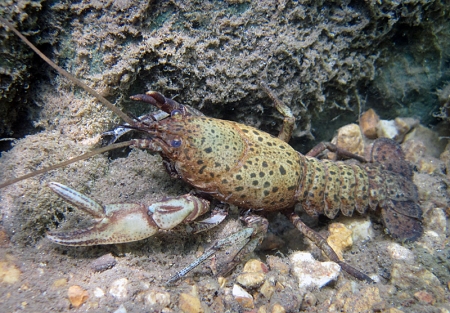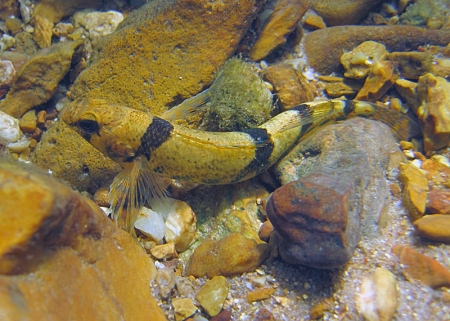Huzzah Conservation Area is located in Crawford County, northeast of Steelville. Within it’s 6,225 acres you can find a mile of Courtois Creek, a half mile of Huzzah Creek and 2 1/2 miles of the Meramec River. Factor in the presence of Onondaga Cave State Park directly across the river and you have some prime real estate. Being only a short distance off of I-44, it’s an easy drive from either St. Louis or Springfield. If you live in Van Buren, however, you’re looking at a 3 hour drive on roads that could make Richard Petty drive like an old woman. I don’t get carsick very often and Dayna is ok as long as she’s driving (she does drive like an old woman,) so we survived the trip and arrived vomit free.
We made the trip on a Saturday in late July. I figured there was a good chance that the easy access from the cities would mean lots of people. I figured correctly. There had to have been thousands of people (I’m not exaggerating) swimming and floating — rafts seemed to be the vessel of choice — on the three streams. I was planning to snorkel, looking for crayfish, but the first few places we tried were so covered up with folks that I don’t think I could have gotten in the water without being trampled. And they had the water stirred up enough to make a bugger of taking photos.
It didn’t occur to me to take photos of the crowds until we were leaving when I got this shot from the Meramec River bridge:
Hwy H Meramec River Bridge, looking downstream
Keep in mind that this was after six o’clock in the evening and the gravel bar was still this crowded. Now imaging something on the order of 10 times as many people and many more canoe buses and you have an idea of what it looked like when we arrived.
Having driven three hours, I wasn’t planning to give up. We kept driving around and finally ended up at an access on Courtois Creek, about a half mile above it’s confluence with Huzzah Creek. There was a crown here too, but they were all putting rafts, tubes and kayaks on the water and going downstream. We headed upstream and, other than a handful of canoes and kayaks, had the creek all to ourselves. A little perseverance goes a long way some times.
Two views of Courtois Creek
Now that I had a “safe” place to snorkel, it was time to hit the water. I saw four species of crayfish including Orconectes luteus, O. medius and O. punctimanus. I photographed all three, but none of the O. punctimanus shots were useable.
Orconectes luteus (Golden Crayfish)
Orconectes medius (Saddlebacked Crayfish)
But the most numerous crayfish, the reason I had made the trip and the star of the show was Cambarus maculatus, the Freckled Crayfish.
I had only seen C. maculatus once before, pulled from underneath a large rock in Big River at Leadwood Access. The water was murky that day and I got no decent photos, but this day Courtois Creek was as clear as you could hope for. I found at least two dozen C. maculatus, all from the rocks near the stands of water willow that you can see in the photos of the creek above. They ranged in size from near three inches to small, one inch juveniles.
C. maculatus is endemic to the Meramec River and further limited to the central and eastern (Big River) parts of the drainage, apparently absent from the upper Meramec, Dry Fork and Bourbuese River. Despite being on the Missouri Species of Conservation Concern, C. maculatus is nonetheless placed in the “Least Concern” category by the IUCN Red List of Threatened Species. The reasoning behind their ranking is that the species, despite having a restricted range, is widespread and fairly common within that range, and not known to face any immediate threats.
Surprisingly, C. maculatus wasn’t described until 1988. It amazes me that such a distinctive species, inhabiting a heavily used river drainage, could escape the notice of science until such a recent time.
C. maculatus is not easily confused with any other species, though C. hubbsi shares it’s strong, stocky build and in some individuals, a similar yellow-tan coloration. The two species do not occur together and the spots of C. maculatus and the dark saddle mark at the rear of the abdomen in C. hubbsi make them easy to distinguish, at least in living specimens.
C. maculatus is closely related to C. hubbsi, as well as C. rusticiformis (Depression Crayfish) from Kentucky and Tennessee. Not having any experience with C. rusticiformis, I can’t speak to it, but I can say that the behavior of C. maculatus is very similar to that of C. hubbsi. Both apparently spend most of their time beneath well seated rocks. Neither are strong swimmers that rarely try to escape when uncovered, instead hunkering down in their depression and staying still. I’ve yet to see a C. maculatus in the open and, in a much larger sample, have only seen two C. hubbsi that weren’t hiding under a rock, both on the same day in McKenzie Creek on the Black River.
C. maculatus reaches approximately 1.3 inches in length by the end of it’s first year and 2.5 inches after two. C. maculatus is relatively long lived for a crayfish — at least 4 years — and maxes out at roughly 3.5 inches long. Males and females grow at roughly the same rate and reach the same maximum size.
One last thing before I wrap up what’s becoming a very long post. While photographing C. maculatus, I found another Meramec River endemic and I had to show the best of the few photos of it that I managed to shoot.
This is Etheostoma erythrozonum, the Meramec Saddled Darter, and the only fish known to be endemic to the Meramec. Previously considered to be E. tetrazonum or Missouri Saddled Darter, a species whose range included the Gasconade, Osage and Moreau River drainages as well as the Meramec. In 1984, considerable genetic divergence was uncovered between the E. tetrazonum populations in the Osage and Meramec drainages. A recent molecular phylogenetic analysis of 13 populations of E. tetrazonum supported this and the Meramec population was split off into E. erythrozonum. There are morphological differences between the two species as well, but I’m not going to list them here. However, there’s a link to the species description paper in the references below and it details all of the differences.
Ok, I’m done now. More crayfish coming next.
| References: |
| Crandall, K.A. 1998. Conservation phylogenetics of Ozark crayfishes: assigning priorities for aquatic habitat protection. Biological Conservation 84(2):107-117. |
| Hobbs, H.H., Jr. and W.L. Pflieger. 1988. Cambarus (Erebicambarus) maculatus: A new crayfish (Decapoda: Cambaridae) from the Mecamet River Basin of Missouri. Proceedings of the Biological Society of Washington, 101: 644-652. |
| Pflieger, W.L. [B. Dryden, editor]. 1996. The Crayfishes of Missouri. Missouri Department of Conservation, Jefferson City, Missouri. 152 pp. |
| Switzer, J.F., and Wood, R.M., 2009, Etheostoma erythrozonum, a new species of darter (Teleostei: Percidae) from the Meramec River drainage, Missouri: Zootaxa, no. 2095, p. 1-7. |
